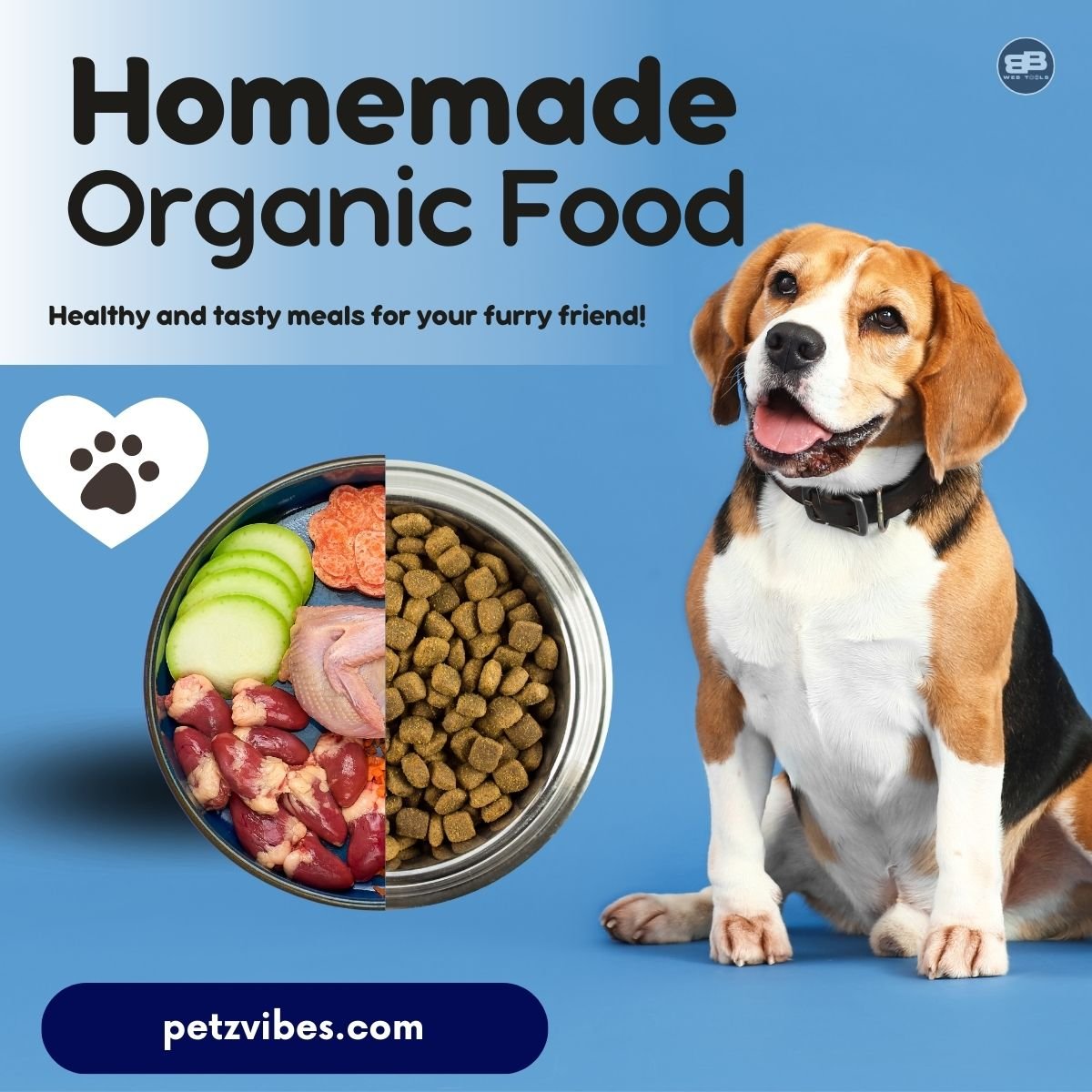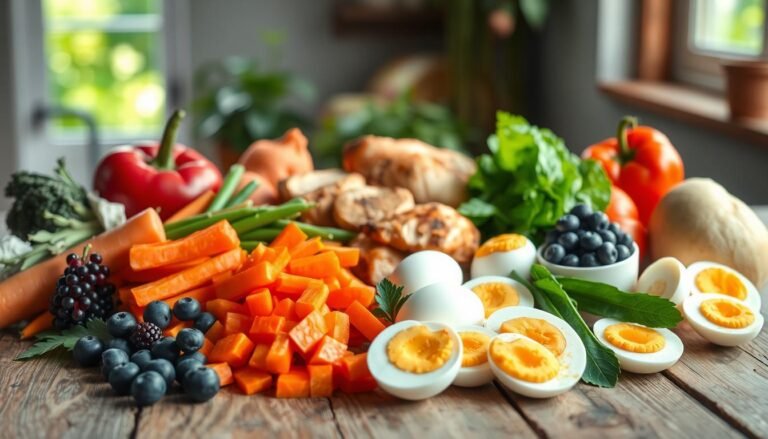Homemade organic pet recipes are the perfect way to give your dog the wholesome, nutrient-rich meals it deserves without the artificial additives in many commercial kibbles.
As pet owners, we know our furry friends thrive on real, high-quality ingredients, so we’ve created five vet-approved, tail-wagging recipes packed with organic goodness. From protein-packed bowls to veggie-rich bites, these dishes aren’t just healthy – they’re so delicious, your pup will lick the bowl clean (and maybe even ask for seconds!).
Say goodbye to questionable fillers and hello to happy, healthy mealtimes!

Disclosure: PetzVibes.com is a free online platform that provides valuable content and comparison services. To keep this resource free, we may earn advertising compensation or affiliate marketing commissions from the partners featured in this blog.
Key Takeaways
- 5 simple and healthy recipes to make at home for your dog
- Benefits of switching to homemade meals for your dog’s health
- Essential nutrients required for a dog’s overall well-being
- Tips on storing homemade dog food to maintain freshness
- The importance of consulting with a veterinarian before making dietary changes
Why Make Homemade Organic Food for Your Dog
Preparing your dog’s meals at home using organic ingredients can significantly enhance their well-being. As pet owners, we strive to provide the best possible care for our dogs, and their diet plays a crucial role in their overall health. Homemade diets can particularly benefit dogs with sensitive stomachs. Eliminating common irritants and focusing on easily digestible ingredients can help alleviate gastrointestinal issues. For more information on feeding dogs with sensitive stomachs, visit our guide: Best Food for Dogs with Sensitive Stomachs.
Health Benefits of Homemade Dog Food
Making homemade dog food can lead to numerous health benefits for your pet. Organic ingredients can improve your dog’s digestion, increase their energy levels, and promote a shinier coat. Many commercial dog foods contain fillers and preservatives that can cause allergies and digestive issues in dogs. You can avoid these potential health risks by preparing your dog’s meals at home.
Some pet owners have reported fewer vet visits and health issues after switching to homemade organic food. This is likely due to the ability to tailor the diet to the dog’s needs and avoid harmful additives. A well-balanced homemade diet can improve overall health and reduce the risk of specific health problems.
| Health Benefit | Description |
|---|---|
| Better Digestion | Avoiding fillers and preservatives can lead to a healthier digestive system. |
| Increased Energy | Balanced nutrients can result in more energetic and lively dogs. |
| Shinier Coat | Proper nutrition promotes healthy skin and a shiny coat. |
Control Over Ingredients and Quality
One significant advantage of homemade dog food is the control it gives you over the ingredients and their quality. You can reduce your dog’s exposure to pesticides and other harmful chemicals by choosing organic ingredients. This level of control allows you to ensure that your dog gets the nutrients it needs without the risk of consuming artificial additives.
“Feeding my dog homemade organic food has made a significant difference in their health. Their coat is shinier, and they have more energy.”
By controlling the quality of ingredients, you can also tailor your dog’s diet to address specific health concerns or dietary restrictions. This personalized approach to nutrition can lead to better nutrient absorption and overall improved health outcomes for your dog.
Essential Nutrients Your Dog Needs in Homemade Organic Pet Recipes
Creating a balanced homemade dog food requires understanding the essential nutrients your dog needs to thrive. A well-balanced diet is crucial for maintaining your dog’s overall health, and homemade organic pet recipes can provide the necessary nutrients correctly.

Protein Sources for Optimal Health
Protein is a critical component of your dog’s diet, and very lean ground beef or poultry is an excellent source. These protein sources are rich in amino acids, vital for your dog’s health. Other beneficial protein sources include eggs, which provide folic acid and vitamin B12, and beef liver, which is rich in copper, zinc, and iron.
Healthy Fats and Omega Fatty Acids
Healthy fats, particularly omega-3 and omega-6 fatty acids, play a significant role in your dog’s diet. Hempseed is an excellent source of these essential fatty acids, helping to balance the fats in your dog’s diet. Sardines are another valuable source, providing vitamins E and D.
Vegetables and Fiber for Digestion
Vegetables are vital to a balanced homemade dog food diet, adding antioxidants, phytonutrients, enzymes, and fiber. Broccoli, red bell pepper, and spinach are excellent choices, supporting healthy digestion and overall well-being. Including various vegetables ensures your dog receives a broad spectrum of nutrients.
Incorporating these essential nutrients into your homemade organic pet recipes ensures your dog gets a balanced and nutritious diet. It’s all about providing the right balance of protein, healthy fats, and vegetables to support your dog’s optimal health. As emphasized, “A well-rounded diet is key to a healthy, happy dog.”
5 Delicious Homemade Organic Pet Recipes
Now, let’s dive into the heart of our guide: 5 delicious homemade organic pet recipes that your dog will love. These recipes are nutritious and tailored to meet your furry friend’s nutritional needs.
Beef and Vegetable Power Bowl
This recipe is a powerhouse of nutrition. It combines lean ground beef with various vegetables to provide a balanced meal for your dog.
Ingredients List
- 1 lb lean ground beef
- 1 cup mixed vegetables (such as broccoli and bell pepper)
- 1/2 cup cooked brown rice
- 1 teaspoon kelp powder
Preparation Instructions
Begin by cooking the ground beef in a non-stick pan until thoroughly browned. Then, add the mixed vegetables and cook until they’re tender. Mix in the cooked brown rice and kelp powder. Serve once cooled.
Chicken and Brown Rice Delight
This recipe is a great source of protein and fiber, making it an excellent option for dogs needing more energy.
Ingredients List
- 1 lb boneless, skinless chicken breast
- 1 cup cooked brown rice
- 1/2 cup steamed vegetables
- 1 teaspoon flaxseed oil
Preparation Instructions
Cook the chicken breast until it’s done, then chop it into small pieces. Mix with cooked brown rice, steamed vegetables, and flaxseed oil. Serve warm or at room temperature.
Turkey and Vegetable Medley
Ground turkey is another excellent protein source for dogs. When combined with a variety of vegetables, it creates a nutrient-rich meal.
Ingredients List
- 1 lb ground turkey
- 1 cup mixed vegetables (such as carrots and green beans)
- 1/2 cup cooked quinoa
- 1 teaspoon dried kelp
Preparation Instructions
Cook the ground turkey in a pan until it’s fully browned, breaking it into small pieces as it cooks. Add the mixed vegetables and cook until they’re tender. Stir in the cooked quinoa and dried kelp. Serve once cooled.
Sardine and Sweet Potato Superfood Mix
Sardines in water are a rich source of fatty acids essential for your dog’s skin and coat health.
Ingredients List
- 1 can of sardines in water, drained
- 1 large sweet potato, cooked and diced
- 1/4 cup chopped fresh parsley
- 1 teaspoon coconut oil
Preparation Instructions
Mix the drained sardines with cooked sweet potato, chopped parsley, and coconut oil. Serve as a nutritious topper or mix into your dog’s regular meal.
Organ Meat and Vegetable Nutrient Boost
Incorporating organ meats like liver into your dog’s diet can provide a rich source of vitamins and minerals.
Ingredients List
- 1/2 lb beef liver
- 1 cup mixed vegetables
- 1/4 cup cooked brown rice
- 1 teaspoon fish oil
Preparation Instructions
Cook the beef liver until it’s done, then chop it into small pieces. Mix with the mixed vegetables, cooked brown rice, and fish oil. Once cooled, serve.
As experts emphasize, “A well-balanced homemade diet can significantly improve your dog’s overall health and well-being.” By incorporating these recipes into your dog’s meal routine, you can ensure it’s getting the nutrients it needs to thrive.
“Feeding your dog a homemade diet can be a great way to ensure they’re getting the nutrients they need, as long as you’re doing it correctly.”
Storage and Serving Tips for Homemade Dog Food
Following proper storage and serving guidelines is essential to getting the most out of homemade dog food. This ensures your dog receives the nutrients it needs while maintaining food safety.
Proper Portion Sizes for Different Dogs
Determining the correct portion sizes for your dog is crucial. Check with your veterinarian to determine how much food your dog needs per serving based on weight, age, and activity level. For example, dogs that weigh around 10 pounds typically require 2-3% of their body weight in food daily. We feed our dogs twice daily, once in the morning and once in the evening.
- Consider your dog’s weight and age when deciding on portion sizes.
- Adjust portion sizes based on your dog’s activity level and metabolic needs.
Freezing and Thawing Methods
When it comes to storing homemade dog food, freezing is a great option. Uncooked food can be safely stored in the freezer for weeks, but it’s best to consume cooked food within a few days. Consider using reusable freezer bags to reduce waste.
To thaw frozen dog food, leave it in the fridge overnight or quickly submerge the container in cold water. Always check the food for any signs of spoilage before serving.

Conclusion: Transitioning Your Dog to Homemade Organic Food
Embracing homemade organic pet recipes is a decision that can significantly enhance your dog’s overall well-being. By making the switch, you can expect improved health outcomes and the joy of seeing how much your dog loves these nutritious meals. We recommend gradually transitioning from commercial kibble to homemade food to avoid digestive upset. Monitor your dog’s response and adjust as needed. Ensuring nutritional completeness is crucial; consult your veterinarian about potential supplements. You can maintain a balanced diet while experimenting with new ingredients with the recipes provided. Homemade dog treats can also be made using similar ingredients for a fully organic feeding approach. Take the first step in improving your dog’s diet with these healthy, homemade recipes that dogs love.
FAQ
What are the benefits of making dog food in a food processor?
How long can I store homemade dog food in the fridge?
Can I use lean ground beef as a protein source for my dog?
How often should I feed my dog sardines?
Are bell peppers safe for dogs to eat?
Can I freeze dog food for later use?
How do I determine the correct portion sizes for my dog?
Can I use broccoli as a vegetable ingredient in dog food?
Resources
Homemade Dog Food Recipes: Choosing Balanced Ingredients https://www.akc.org/expert-advice/nutrition/choosing-ingredients-homemade-dog-food/
Cooking for Your Dog: Do’s & Don’ts of Homemade Dog Food https://www.akc.org/expert-advice/nutrition/cooking-for-your-dog-dos-and-donts/
Unleashing the Benefits of Homemade Fresh Dog Food https://www.akc.org/expert-advice/nutrition/benefits-of-homemade-dog-food/






